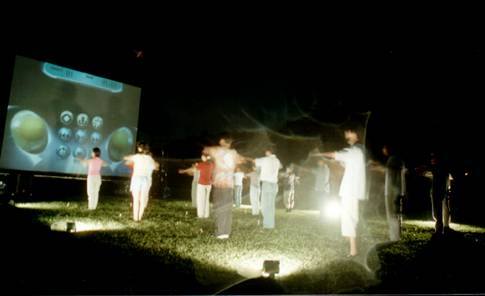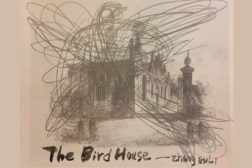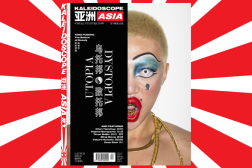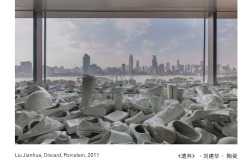

Homeport Harbor City
Time: August 31st to September 1st, 2001
Venue: Fuxing Park
Internationally, harbor cities have always maintained economic and cultural ties, which not only shaped the look and design of these cities, but has also greatly influenced the composition of their populations. Many people, such as migrants and fortune seekers, but also refugees from all corners of the world, have found homes in these port cities, far away from their own country of origin. It is this very mixture of cultures that lends harbor cities their special atmosphere.
Modern means of communication, such as the Internet, have intensified these international contacts and fundamentally changed them. The digital culture that washes over the entire world has not left these harbor cities untouched. What are the consequences of new technology in the daily lives of those who reside in homeports?
In the project Homeport Cell--initiators of incidents track down these changes. Homeport is like a voyage along six very different harbor cities spread over several continents. In the course of 2001 five non-western harbor cities, besides Rotterdam, are analyzed: Havana, Shanghai, Mumbai, Jakarta and Cape Town. In all of these cities local artists or artistic groups have been invited to express their vision on their own rapidly changing ‘homeport.’ They develop new artworks for the public spaces in their cities, at one or more locations that the artists feel are of special significance to the development of their own homeport, such as: the dockworkers’ quarters in Havana, a city park in the heart of Shanghai or an old harbor railway line in Mumbai.
Each time Homeport arrives in a new homeport location a program of cultural activities for and by the inhabitants of that city begins. The participants in the Homeport cities have been chosen on the basis of how they manage to incorporate their own cultural and historical background into contemporary works of high quality art.
How does this translate into practice? A broad selection of participants have been chosen, representing disciplines that are emblematic of the current life, housing and work in these cities.
Homeport and Six Harbor Cities
Homeport Havana
April 2001: A dance festival took place in the dockworkers’ quarters and in Havana’s city center, based on a choreography that depicted the turbulent history of daily life in Cuba and was especially conceived for Homeport.
Homeport Rotterdam
June/July 2001: Three installations were presented that deal with (digital) communication, an interesting approach in a ‘homeport,’ where the harbor itself has all but vanished from daily life.
Homeport Shanghai
August 2001: Artists will present video installations and performances in Fuxing city park for 48 hours–technology nestled in the busy epicenter of this rapidly evolving city.
Homeport Mumbai
September 2001: Here a project is being developed that focuses on the ancient oral tradition of story telling, in the many languages spoken by the international dockworkers.
Homeport Jakarta
November 2001: An open air cinema that was founded especially for Homeport in a kampung, within the city’s harbor area, will screen experimental films and documentaries by young independent filmmakers.
Homeport Cape Town
December 2001: Artists will present a program based on the former maritime defense system of Cape Town, keeping in mind both the burden of its past and the hope its future holds.
Homeport can be experienced by reading the Homeport newspaper, which are nationally available for free in the various international Homeport cities. Please visit our website Homeport Portal, where you will find a timeline of the project and can surf to the various city sites; the website was created by designers from the numerous Homeport regions.
Altered, Modified, Different
4 Artists Interpret their Homeport Shanghai
Like the phoenix? Shanghai has transformed from a small fishing village into a busy international metropolis. The city is located on the Yangzi River delta by the East China Sea. It is to this superb geographical position that Shanghai owes its development over the last 1,000 years–right up until the opening of the port in modern times.
Now, with the turn of the new century, Shanghai has been reincarnated. The phoenix is rising once again, the “Pearl of the East” sparkles brightly from the coast of the East China Sea. Ships from all directions are berthing at Shanghai’s harbor to transport goods and passengers from all over the world, bringing with them a mixture of cultures and new, pluralistic, and positive ideas.
Shanghai is known as a sea in which Chinese and western elements combine, mixing traditional and modern, linking ancient and new. Subtle, refined culture exists alongside pop culture, virtue mingles with vice, covering all manifestations of nature. Floating in this sea are the colors, flavors, and voices of the world. How do we express such a unique scenery?
Shanghai’s contribution to the Homeport project is a contemporary art exhibition, Modified, Altered, Different, which presents video installations to Shanghai residents in Fuxing Park on the evenings of August 31st and September 1st.
Homeport Cell organizers and the project’s Shanghai based co-organizers, the Dutch Consulate and Shanghai Bizart Ltd., think that this open theme will bring out Shanghai’s characteristics particularly well. Because of the choice of exhibition space and artwork, the audience will become more aware of these special characteristics.
The French garden-styled Fuxing Park is located close to Shanghai’s most flourishing downtown shopping area–Huai Hai Zhong Road; it is often a venue for large-scale cultural and arts events. This contemporary video installation, will most likely be the first time something like this has happened in Shanghai. At a meeting point for people, as well as a space for exchange and leisure, the video installations in the park will remind viewers of a 1980’s open-air cinema.
Now, digital and multimedia materials used in this new media art will undoubtedly be, for most visitors, a completely new experience. In the relaxing atmosphere of the park, a remote and unfamiliar art program will integrate a broad spectrum of people and their own lives into the project itself. The audience becomes a part of this experimental project.
Yang Zhenzhong, Yang Fudong, Liang Yue and Song Tao are the four artists taking part in this exhibition. All of them are living in Shanghai, and have been very active as new media artists during the last few years.
Yang Zhenzhong’s work for the exhibition is a video-installation titled Keep Still, in which he uses 12 TV sets and video recorders. The video shows a person’s face continuously speaking the words “keep still” while a camera lens is taking pictures with 12 moving methods.
Yang Fudong will introduce his short film Robbery. In this new piece, the audience will appreciate the abstract scenes created through the language of imagery.
Liang Yue’s video installation is a projection in a tent, with a height of 5.5 meters and a diameter of over 7 meters. The video will show a person staring upwards at a Heaven that seems to be near, but remains far away and out of reach.
Song Tao’s work entitled Exercise combines performance, projection and musical elements. He invited 16 students from a school for the deaf/mute to do gymnastics in time to radio music on a grassy field in the park, which will be transmitted on a 4-6 meter projection screen.
Out of these works the audience is able to see the artists’ respective concepts and ideas. Living and working in a sensitive, and yet ironically ordinary way in the city, the artists have found their own positions within Shanghai, and they use their artworks to indicate their own views on the world and our age.
After 48 hours of a Modified, Altered and Different experience in the harbor city of Shanghai, the Homeport project will cast off again, fully loaded with Shanghai’s rich flavor, heading for the next port of destination on its cultural sea voyage.
Text by Lu Leiping
Translation by Simone Schiefke




